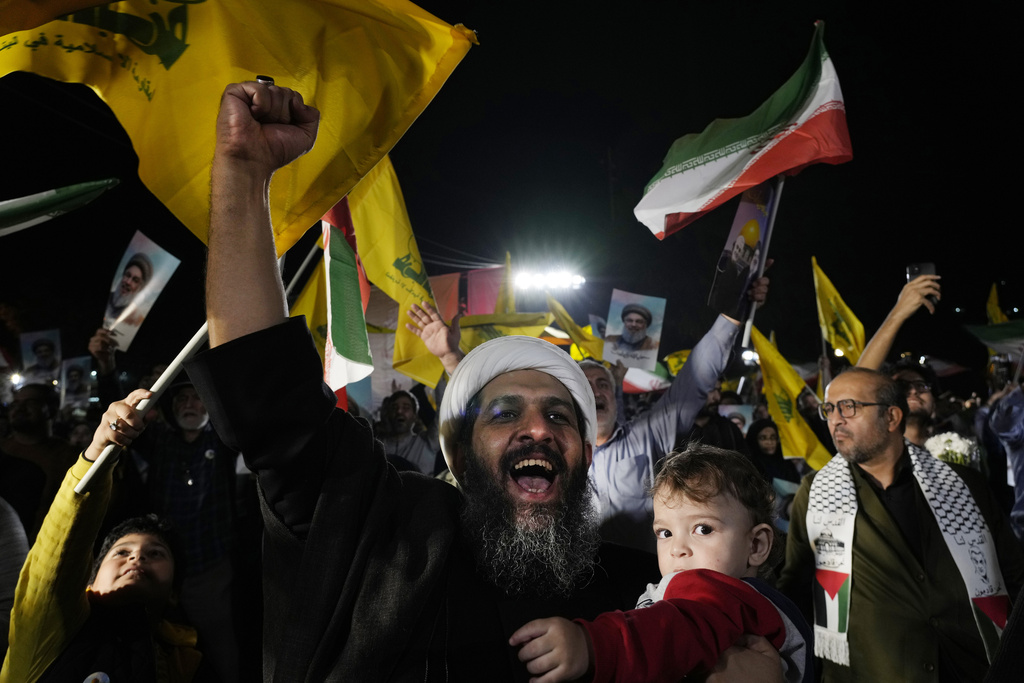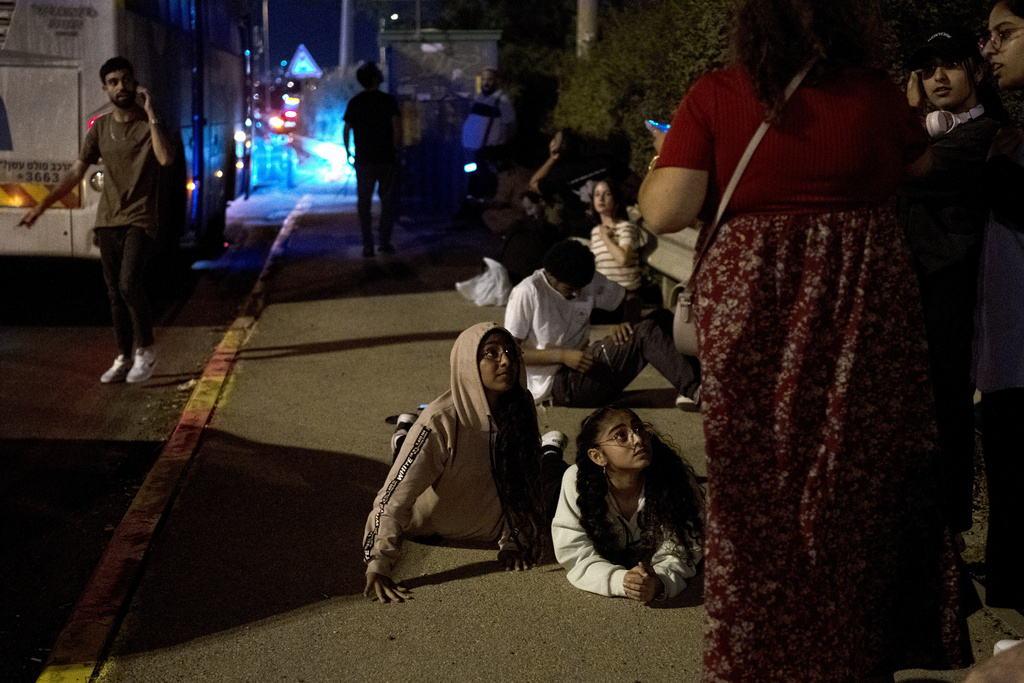Iran Fires 180 Missiles at Israel Amid Escalation \ Newslooks \ Washington DC \ Mary Sidiqi \ Evening Edition \ Iran launched at least 180 missiles into Israel, escalating the ongoing conflict that has intensified in recent weeks. Israel responded by promising retaliation and conducted limited ground incursions into southern Lebanon against Hezbollah. The exchange adds to fears of a broader regional conflict involving multiple Middle Eastern nations.

Iran Launches Missile Attack on Israel: Quick Looks
- Missile Attack on Israel: Iran fired over 180 missiles into Israel, striking central and southern areas.
- Air Raid Sirens Activated: Residents across Israel took shelter as air defenses intercepted many missiles.
- Retaliation Promised: Israeli Prime Minister Benjamin Netanyahu vowed retaliation, calling the attack a “big mistake.”
- Escalation with Hezbollah: Israel conducted limited incursions into southern Lebanon, targeting Hezbollah positions.
- Hezbollah’s Response: Hezbollah continued firing rockets into Israel amid Israeli artillery and airstrikes.
- Ground Incursion Confusion: Conflicting reports emerged over whether Israeli troops fully entered Lebanon.
- International Reaction: U.S. and U.N. officials expressed concerns, with the U.N. calling an emergency meeting.
- Casualties and Evacuations: Over 1,000 people have been killed in Lebanon, and mass evacuations are underway.
Deep Look
On Tuesday, Iran launched at least 180 missiles into Israel, heightening the tension in an already volatile conflict between the two regional adversaries. The strikes represent a significant escalation in the ongoing hostilities that have been simmering for years between Israel and Iran, alongside their respective allies, and bring the Middle East closer to the brink of a wider regional war.
The attack unfolded against a backdrop of flashing air raid sirens across Israel, with a fiery orange glow illuminating the night sky as the missiles were intercepted or hit their targets. Residents rushed into bomb shelters as Israel’s defense systems engaged the barrage. Despite the scale of the attack, Israeli officials reported only a few injuries, and Israel vowed retaliation. Prime Minister Benjamin Netanyahu condemned Iran’s actions, stating, “Iran made a big mistake tonight and it will pay for it.”
The missile strike was the latest flashpoint in the extended shadow war between Israel and Iran, as the two nations have rarely faced each other in direct conflict. Israel has long viewed Iran as its most dangerous adversary due to Tehran’s frequent calls for Israel’s destruction, its nuclear ambitions, and its support for militant groups in the region. Iran, meanwhile, denies Israeli accusations that it is developing nuclear weapons, asserting that its nuclear program is for peaceful purposes.
The missile attack follows weeks of heightened military activity, with Israel launching a series of devastating blows against Hezbollah’s leadership in Lebanon. The escalation began when Israel initiated airstrikes that resulted in the death of key Hezbollah leaders, including Hassan Nasrallah, the group’s top commander. In response to increased rocket fire from Hezbollah since the Gaza conflict began, Israel further escalated by launching what it called a “limited ground incursion” into southern Lebanon, aimed at dismantling Hezbollah infrastructure and eliminating threats near the Israeli border.
Israeli military spokesperson Rear Admiral Daniel Hagari reported that the nation’s air defenses successfully intercepted many of the incoming Iranian missiles, though several did strike in central and southern Israel. The national rescue service confirmed that two people suffered minor injuries from shrapnel. In the West Bank, a Palestinian man was reportedly killed by a missile near the town of Jericho, though it was unclear which side had launched the projectile.
In response, Hezbollah, a militant group backed by Iran, continued to fire rockets at Israel, targeting both civilian and military locations. The group has vowed to continue its strikes until a ceasefire is declared in Gaza, where Hamas, also supported by Iran, has been engaged in an intense confrontation with Israel. Hezbollah has positioned itself as a key player in the larger conflict, linking its own military actions to developments in Gaza.
Israel’s retaliation also extended to ground operations. Rear Admiral Hagari stated that Israel had conducted limited incursions into southern Lebanon, primarily to gather intelligence and destroy Hezbollah’s military infrastructure, such as tunnels and weapons caches. He emphasized that Israel had no plans for a broader invasion similar to its past incursions into Lebanon or its current offensive in Gaza against Hamas, stating, “We’re not going to Beirut.”
There were conflicting accounts regarding the extent of Israeli troop activity inside Lebanon. While Israeli forces reported crossing the border for targeted operations, Hezbollah denied that Israeli ground troops had fully entered Lebanon. An Associated Press reporter observed Israeli military vehicles and helicopters operating near the border, but could not confirm any substantial movement of troops into Lebanon. Additionally, U.N. spokesperson Stephane Dujarric stated that the United Nations peacekeeping force in southern Lebanon had observed some Israeli military activity, but no full-scale invasion.
Amid these developments, Iranian officials justified their missile launch as retaliation for the recent Israeli airstrikes that killed several prominent figures, including Hezbollah leader Hassan Nasrallah and Iranian Revolutionary Guard General Abbas Nilforushan. Tehran also cited the assassination of Ismail Haniyeh, a high-ranking Hamas official, in July in a suspected Israeli operation in Tehran. These targeted killings have dealt significant blows to Iran’s network of allied groups across the region, adding further impetus to Tuesday’s retaliatory attack.
The situation grew even more complicated with reports of a deadly shooting attack in Tel Aviv just moments before Iran’s missiles were launched. At least six people were killed, and the two suspects involved in the attack were shot dead by police. This incident added to the chaos of an already dangerous night in Israel.
The international community quickly took notice. White House National Security Adviser Jake Sullivan characterized Iran’s missile barrage as a “significant escalation” but noted that the attack was ultimately “defeated and ineffective,” in part due to assistance from the U.S. military, which helped intercept some of the incoming projectiles. President Joe Biden expressed full support for Israel and announced that his administration was in “active discussion” to determine an appropriate response to Tehran’s aggression. The United Nations Security Council scheduled an emergency meeting for Wednesday morning to address the situation, underscoring the seriousness of the escalation.
This is not the first time Iran has directly attacked Israel in recent months. In April, Iran launched a barrage of drones and missiles at Israel, though the majority of those projectiles failed to reach their intended targets. A U.S.-led coalition intercepted many of them, while others either malfunctioned or crashed during flight.
On Tuesday morning, the Israeli military extended a warning to residents of southern Lebanon, urging them to evacuate north of the Awali River, a full 60 kilometers from the border. This was a significant expansion of the previously established evacuation zone north of the Litani River, which was intended as a buffer after the 2006 Lebanon war. The scope of this evacuation notice has raised questions about how deep Israeli forces may plan to move into Lebanese territory.
As the fighting escalated throughout Tuesday, Hezbollah launched a rare volley of rockets toward central Israel, wounding at least one person. Hezbollah also claimed to have fired a new type of medium-range missile at the headquarters of Israeli intelligence agencies near Tel Aviv, as well as targeting military personnel near the border. Meanwhile, Israeli artillery and airstrikes pounded Hezbollah positions in southern Lebanon, with no immediate word on casualties from either side.
The broader implications of these latest hostilities are significant. Hezbollah and Hamas are close allies, both heavily backed by Iran, and each round of escalation brings fears of a wider war that could pull in more countries, including the United States. In recent weeks, the U.S. has bolstered its military presence in the region, positioning assets to support Israel if needed. The potential for a broader conflict involving multiple nations looms large, especially with Iran’s direct involvement in missile strikes.
The human cost of the escalation has been immense, particularly in Lebanon. Over 1,000 people have been killed in the country over the past two weeks, nearly a quarter of them women and children, according to Lebanon’s Health Ministry. Hundreds of thousands of residents have been forced to flee their homes in the southern part of the country as Israel continues its airstrikes and shelling against Hezbollah targets. Despite the mounting toll, Hezbollah remains resolute, with its acting leader, Naim Kassem, stating that commanders killed in recent weeks have already been replaced, signaling the group’s intent to continue its fight.
As tensions reach new heights, European nations have begun withdrawing their diplomats and citizens from Lebanon in anticipation of further escalation. The uncertainty of the situation, combined with the possibility of a broader regional conflict, has prompted many to leave the area before the situation worsens.
The conflict between Israel and Iran, and their respective proxies, shows no signs of abating, with both sides entrenched in a cycle of retaliation. As regional and international actors prepare for what may come, the path forward remains fraught with danger, with the potential for a larger confrontation that could reshape the Middle East.
Iran Fires Iran Fires Iran Fires







